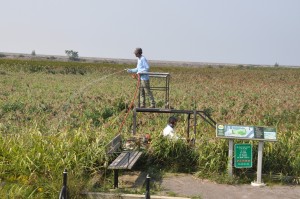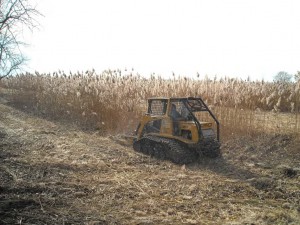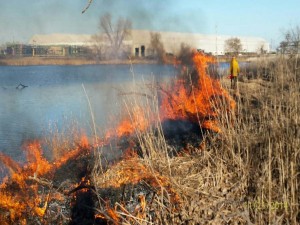Linda Nelson and Andrew Kornacki, U.S. Army Corps of Engineers
March 2015
Phragmites australis (common reed) is one of the most troublesome invasive plants encountered on the U.S. Army Corps of Engineers (USACE) aquatic ecosystem restoration projects. The USACE Buffalo, Chicago, and Detroit districts, in coordination with scientists at the Engineer Research and Development Center, Environmental Laboratory, have developed an ecosystem restoration project team to investigate integrated weed management strategies for managing Phragmites on four restoration projects throughout New York, Ohio, Illinois, and Michigan.
The projects, funded by the Great Lakes Restoration Initiative, strive to improve habitat within or near U.S. Environmental Protection Agency-designated Areas of Concern (AOC).
“When we first looked at doing demonstration projects, we looked at other control projects and noticed they did not show quantifiable success or failure of invasive plant species treatment from start to finish,” said Tony Friona, project liaison for the U.S. Army Engineer Research and Development Center. “Understanding the need for a complete start-to-finish study, the ecosystem restoration project team developed a multi-year plan to combat the invasive species and quantify the effectiveness of our process.”

Herbicide application to control Phragmites australis infestations at Times Beach, Buffalo, New York. Photo Credit: US Army Corps of Engineers, Buffalo District
The approach involves intensive management of Phragmites and other invasive plant species by mowing, prescribed burning, herbicide application, and mechanical removal, followed by re-establishment of native vegetation. The restoration of native vegetation is a key aspect of the multi-year plan, making it truly a start-to-finish study, and also helps to deter the Phragmites from re-establishing itself within the treatment areas.
Identifying new and improved management strategies against phragmites will reduce the invasiveness and spread of this noxious weed, while improving wetland quality and function, restoring high quality native habitats, and increase plant diversity.
“Being able to remove the invasive species from AOCs and restore the native population is a great story, but the true measure of success and the real story is yet to be written. Once the work of the ecosystem restoration project team has been gathered, analyzed, shared, and replicated across the Great Lakes and nation, we will truly see just how important the work an ecosystem restoration project team and demonstration projects were,” Friona said.
For more information on each project site, please view the below websites and fact sheets, or contact Andrew Kornacki, andrew.a.kornacki@usace.army.mil, 716-879-4349.

Mechanical removal is a component of an integrated management approach for removing Phragmites australis and other invasive weed species at Times Beach, New York. Photo credit: US Army Corps of Engineers, Buffalo District
Times Beach, Buffalo, New York
Times Beach is a 56-acre site located within the Niagara River AOC and adjacent to the Buffalo River AOC. It is composed of open water, emergent marsh, forested wetlands and upland habitats. Non-native common reed (Phragmites australis) is the dominant species across all wetland habitats; other targeted invasive plants include common buckthorn (Rhamnus cathartica), Japanese knotweed (Polygonum cuspidatum), and mugwort (Artemisia vulgaris). The five-year restoration project began in the fall of 2012 with completion scheduled for the spring of 2017. The project uses a combination of mechanical cutting/removal and aquatic herbicide applications to control invasive plant species, followed by installation of native plantings. Vegetation and wildlife communities are monitored to determine project success.
Read more about the Times Beach project:
- Our Programs and Projects page
- Army Corps of Engineers Times Beach fact sheet
- Project photos
- Environmental Protection Agency Times Beach press releases
Walnut Beach, Ashtabula, Ohio
Walnut Beach is a 43-acre site located along Lake Erie near Ashtabula, Ohio, and is within the Ashtabula AOC. The site is considered a unique and valuable beach dune/wetland habitat complex. More than half of the site is dominated by non-native invasive plant species including common reed (Phragmites australis), European black alder (Alnus glutinosa) and mugwort (Artemisia vulgaris). A five-year restoration plan began in 2014 and includes mechanical removal, aquatic herbicide treatment and restoration plantings. Monitoring ecosystem responses to vegetation management is an important component of the project.

Prescribed burning, mechanical removal and application of herbicides are used to eradicate Phragmites australis and Phalaris arundinacea at Burnham Prairie Annex, Illinois. Photo credit: US Army Corps of Engineers, Chicago District
Burnham Prairie Annex, Chicago, Illinois
Burnham Prairie Annex, approximately 39 acres in size, is located south of Chicago city limits and adjacent to the Grand Calumet River AOC. A five-year restoration plan began in 2014 and includes an integrated management strategy to control invasive plants primarily non-native common reed (Phragmites australis) and reed canary grass (Phalaris arundinacea) via mechanical removal, application of aquatic herbicides, and prescribed burning. Native wetland plant restoration will follow removal of invasive vegetation. Vegetation monitoring is ongoing to determine effectiveness of deployed management strategies.
Menominee River Area of Concern, Menominee County, Michigan and Marinette County, Wisconsin
This restoration project is scheduled to begin in spring/early summer 2015, and will include treatment of invasive plant species using a combination of mechanical and chemical methods on four islands (Little Blueberry, Blueberry, Boom and Strawberry Islands) located within the Lower Menominee River AOC. Collectively, the islands comprise 17 acres of riverine fringe, wetland and upland habitats. The dominant woody and herbaceous invasive plants targeted for treatment and removal include common buckthorn (Rhamnus cathartica), glossy buckthorn (Frangula alnus), common reed (Phragmites australis), and various honeysuckle species (Lonicera). Restoration plantings will occur across treated areas. The goal of this three-year restoration project is to restore native vegetative communities on the islands and improve bird rookery habitat.
